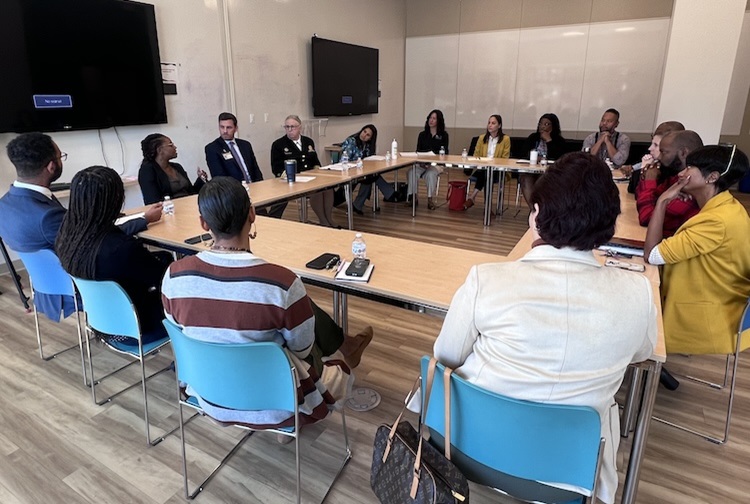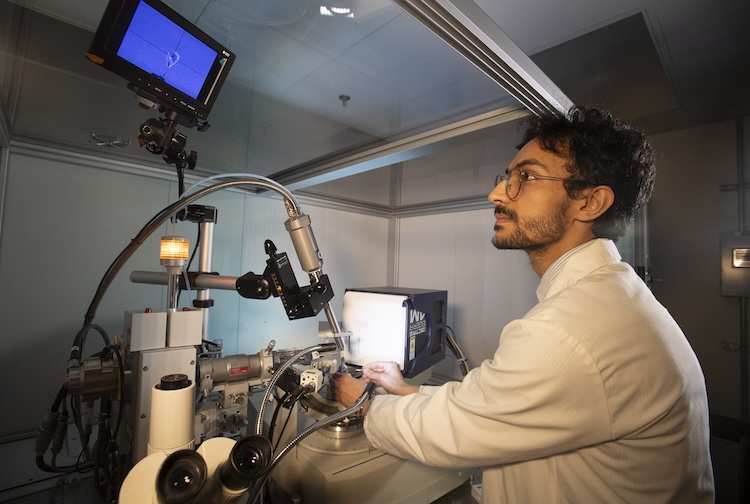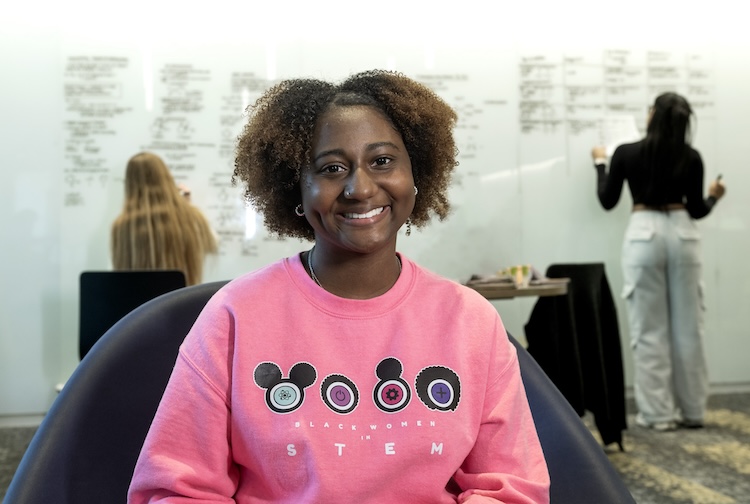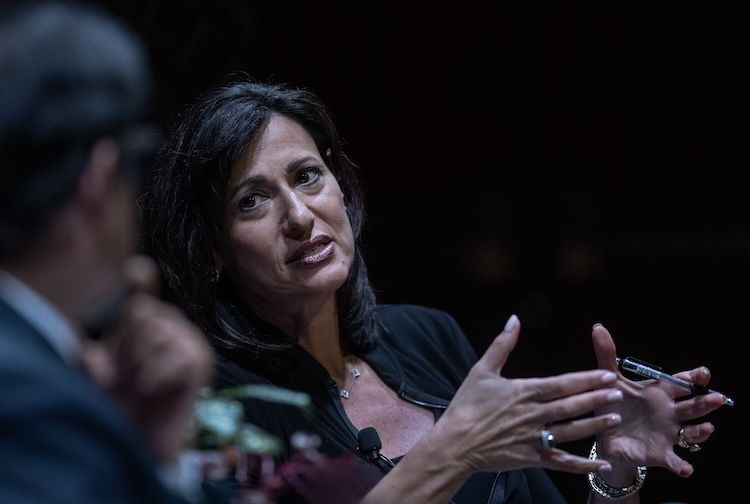
‘Food justice’ – and ideas to achieve it – are spotlighted at VCU Health and U.S. Department of Health and Human Services roundtable
Hunger relief and food insecurity require community-minded, culturally responsive programs in Richmond area and throughout America, participants say.
November 03, 2023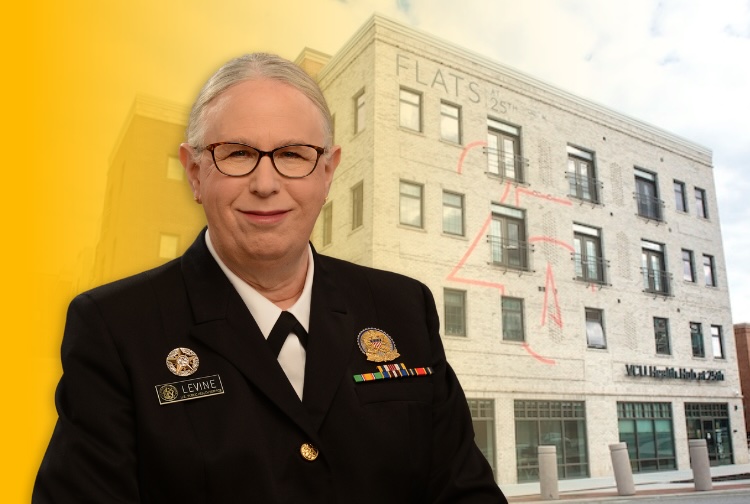 Assistant Secretary of Health Adm. Rachel Levine visited the VCU Health Hub at 25th for a discussion on food insecurity with community partners. (Graphic by Aleixka Block-Macfie)
Assistant Secretary of Health Adm. Rachel Levine visited the VCU Health Hub at 25th for a discussion on food insecurity with community partners. (Graphic by Aleixka Block-Macfie)
By Sara McCloskey
Fighting hunger and promoting “food justice” were key themes of a roundtable this month hosted by VCU Health and the U.S. Department of Health and Human Services (HHS), with local, state and national leaders addressing the progress and pitfalls in Richmond and Central Virginia.
The Oct. 25 event was centered on a visit by Assistant Secretary of Health Adm. Rachel Levine, M.D., to the VCU Health Hub at 25th. The health education and wellness activity center in the East End of Richmond offers free programming by VCU Health and Virginia Commonwealth University faculty, staff and students as well as community partners.
A main goal of HHS is to end hunger in America, Levine says.
“In addition to thinking of economic justice and environmental justice, we want to think food justice,” she said. “It’s not enough to just have food, because you can have fast food. Having a corner store with chips isn’t enough. You need healthy food, nutritious foods.”
Accessing such foods can be a challenge for some households. Roundtable participants – they included Virginia State Breastfeeding Coordinator Jarene Fleming, representatives for congressional lawmakers, community-based anti-hunger organizations, regional food bank Feed More and VCU Health team members – noted barriers such as housing insecurity, transportation, stigma and lack of empowering individuals in the decision-making process.
Organizations represented at the roundtable have different approaches to address systemic problems contributing to food insecurity. Throughout the discussion, participants drew attention to the need for federal agencies to build their programs around community-based efforts and to adapt to unique regional and cultural needs.
Bridging gaps to food access through hospitals and clinics
One method to address food security in medical settings is to consistently screen for it and then connect to community resources. Shari Barkin, M.D., physician-in-chief at Children’s Hospital of Richmond at VCU and chair of pediatrics, says this now happens in many hospitals.
“This is a team sport, so we have to look at how we can create the biggest impact. The main driver we have found [at CHoR] is that families need help activating needed resources and navigating barriers such as lack of transportation and inaccessible busy hours,” Barkin said. “It also is about trust and relationship. People also don’t always feel comfortable asking for help. Rather than assuming people want help, ask families what would be most helpful to them. Approaching these conversations with respect and dignity is critical.”
If patients and families would like help, CHoR team members direct them to the new Family Resource Center to help them connect to the resources they request. This is a family-centered, culturally sensitive approach and follow-up to ensure families get what they need.
VCU Health has a program modeled after the Feed More’s Food is Medicine initiative, which supports food-insecure patients with resources including boxes filled with shelf-stable items. The VCU Health Hub at 25th is one of several participating sites within the health system.
Ivy Bell, a certified community health worker at the VCU Health Hub at 25th, says these types of food distribution efforts are a strong step, but there are still challenges even if food gets into people’s hands.
“Once, a man opened the box to see what was inside and returned it all because he said he couldn’t use any of it. Some people may be homeless and can’t cook the food; others may have a home but don’t have a can opener,” Bell said. “I try to meet people halfway and refer people to soup kitchens and resources, because our food pantries aren’t giving out fresh food that they eat.”
Community organizations that participated in the roundtable have different approaches to address systemic problems contributing to food insecurity. (U.S. Dept. of Health and Human Services)
Culturally responsive foods and community programs
Other roundtable participants highlighted the importance of food pantries including culturally responsive foods, or foods from different cultures and backgrounds.
Natasha Contreras noticed this need during the COVID-19 pandemic among the Spanish-speaking immigrant population in Chesterfield County and the surrounding area. This led her to create the Waymaker Foundation, a food bank honoring the cultural heritage of Latino and Hispanic communities.
“Growing up, everything was in the backyard – cilantro, tomatoes. And if we didn’t have a vegetable, we would go to our neighbor’s house to see if they had it,” Contreras said. “When you’re accustomed to that and you don’t have a vegetable in a new community, what do you do? You can work with the next generation, but you can’t change the mind of a 60-year-old to eat out of a can.”
Several of the roundtable organizations are part of efforts to make growing food easier in urban areas and provide education around sustainable practices to reclaim agricultural land. For example, the Small Farm Outreach Program, part of the Cooperative Extension at Virginia State University in Ettrick, works with socially disadvantaged and veteran farmers to sustain farms and ranches independently with training programs.
Food banks across Virginia also recognize the intersection of equity and food insecurity. The Federation of Virginia Food Banks developed a three-year health equity plan, which prioritizes access to culturally responsive foods.
“We recognize that as food banks, there’s no neutral in health equity. You’re either working toward it or against it,” said Meaghan Butler, health equity director of the federation. “We started partnering with healthcare and considering the cultural and health needs of those we serve. Our three-year plan prioritizing health equity also addresses inclusion efforts to ensure our neighbors at the table.”
HHS reinforces that accessibility and nutritional security are directly associated with health outcomes and are imperative for healthy living. The role of community-based partnerships is also crucial to connecting more effectively with the needs of residents, Levine says, which is why visits to the VCU Health Hub at 25th are important in efforts to eliminate barriers to accessing nutritious food that people feel comfortable eating.

